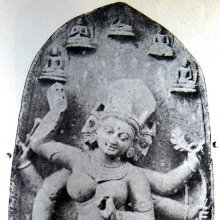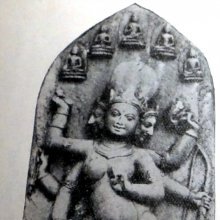Fever: 2 definitions
Introduction:
Fever means something in Hinduism, Sanskrit, the history of ancient India. If you want to know the exact meaning, history, etymology or English translation of this term then check out the descriptions on this page. Add your comment or reference to a book if you want to contribute to this summary article.
Images (photo gallery)
In Hinduism
Natyashastra (theatrics and dramaturgy)
Source: Shodhganga: Elements of Art and Architecture in the Trtiyakhanda of the Visnudharmottarapurana (natya)Walking in Fever is associated with Sthira-gati: one of the various Gatis (“way of walking”) (in Indian Dramas), according to the Viṣṇudharmottarapurāṇa, an ancient Sanskrit text which (being encyclopedic in nature) deals with a variety of cultural topics such as arts, architecture, music, grammar and astronomy.—Sthira-gati denotes the steady movements. To show walking in fever, hunger, disease, tiredness due to penance, dissimulation, excitement, love and sorrow or ease, slow gait should be adopted by the artist. The lover who goes to meet his or her secret lover adopts the sthiragati. In darkness or if a deformed creature is visible or if a person walks a long way, the gait of a person becomes automatically slow down.

Natyashastra (नाट्यशास्त्र, nāṭyaśāstra) refers to both the ancient Indian tradition (shastra) of performing arts, (natya—theatrics, drama, dance, music), as well as the name of a Sanskrit work dealing with these subjects. It also teaches the rules for composing Dramatic plays (nataka), construction and performance of Theater, and Poetic works (kavya).
India history and geography
Source: Singhi Jain Series: Ratnaprabha-suri’s Kuvalayamala-katha (history)Fever (causing suffering) represents a scene of human life commonly depicted on the Saṃsāracakra paintings in ancient India, as mentioned in the Kathās (narrative poems) such as Uddyotanasūri in his 8th-century Kuvalayamālā (a Prakrit Campū, similar to Kāvya poetry).—Page 185.21 f.: Here follows a description of a printed scroll illustrating the Jaina conception of saṃsāracakra. [...] The saṃsāra-cakra illustrated the three worlds of hell, human world and the world of gods. [For example:] People suffering from many kinds of diseases like fever, pain and burning, and lying on their cots and meeting their deaths, to gather their mourning servants, wives and friends

The history of India traces the identification of countries, villages, towns and other regions of India, as well as mythology, zoology, royal dynasties, rulers, tribes, local festivities and traditions and regional languages. Ancient India enjoyed religious freedom and encourages the path of Dharma, a concept common to Buddhism, Hinduism, and Jainism.
See also (Relevant definitions)
Starts with: Fever bark, Fever bush, Fever flower, Fever leaf, Fever nettle, Fever nut, Fever plant, Fever plant of sierra leone, Fever root, Fever tea, Fever tree, Feverfew, Fevergrass, Feverplant, Feverweed.
Query error!
Full-text (+2551): Jvara, Vishamajvara, Jirnajvara, Pittajvara, Vatajvara, Dahajvara, Jvarita, Vijvara, Tarunajvara, Jvaratisara, Antardaha, Navajvara, Pralepaka, Shitajvara, Prajvara, Samnipata, Samjvara, Jara, Kaphajvara, Udarddha.
Relevant text
Search found 244 books and stories containing Fever, Fevers; (plurals include: Fevers, Feverses). You can also click to the full overview containing English textual excerpts. Below are direct links for the most relevant articles:
Journal of Ayurveda and Integrative Medicine
"AYUSH 64: A pilot study on its effects in Influenza-like illness." < [Volume 13 (issue 1), Jan-Mar 2022]
Repurposing Siddha mercury drug for mild to moderate COVID-19 < [Volume 13 (issue 2), Apr-Jun 2022]
Ayurvedic treatment of COVID-19/SARS-CoV-2: A case report < [Volume 13 (issue 1), Jan-Mar 2022]
World Journal of Pharmaceutical Research
Assessment of types of fevers in a tertiary care hospital < [2016: Volume 5, March issue 3]
Role of vatsanabha in infectious diseases < [2021: Volume 10, April issue 4]
Medicinal plants study at A.V.V.M. Sri Pushpam College, Thanjavur. < [2014: Volume 3, July supplementary issue 5]
Charaka Samhita (English translation) (by Shree Gulabkunverba Ayurvedic Society)
Chapter 3 - The therapeutics of Fever (jvara-cikitsa) < [Cikitsasthana (Cikitsa Sthana) — Section on Therapeutics]
Chapter 1 - The Pathology of Fever (jvara-nidana) < [Nidanasthana (Nidana Sthana) — Section on Pathology]
Chapter 27i - The section on Cow’s milk (Gorasa) < [Sutrasthana (Sutra Sthana) — General Principles]
Rasa Jala Nidhi, vol 4: Iatrochemistry (by Bhudeb Mookerjee)
Treatment for fever (131): Jvarashani rasa < [Chapter II - Fever (jvara)]
Treatment for fever (168): Umaprasadana rasa < [Chapter II - Fever (jvara)]
Treatment for fever (169): Jvarankusha rasa < [Chapter II - Fever (jvara)]
Jivanandana of Anandaraya Makhin (Study) (by G. D. Jayalakshmi)
Medicines administered for different diseases < [Chapter 4 - Āyurvedic principles in Jīvanandana Nāṭaka]
Sannipātas (fevers due to Vāta, Pitta and Kapha) < [Chapter 4 - Āyurvedic principles in Jīvanandana Nāṭaka]
Act VI (Summary) < [Chapter 3 - Summary of the Play Jīvānandana Nāṭaka]
The Malaysian Journal of Medical Sciences
The Deadly Ebola Threat in the Midst of an Overwhelming Dengue Epidemic < [Volume 21 (issue 6), Nov-Dec 2014]
Causes of Fevers of Unknown Origin in Benin City, Nigeria < [v.21(1): 1–76 2014 Jan]
New Advances in the Diagnosis of Typhoid and Detection of Typhoid Carriers < [v.7(2): 1–68 2000 Jul]
Related products
(+76 more products available)








